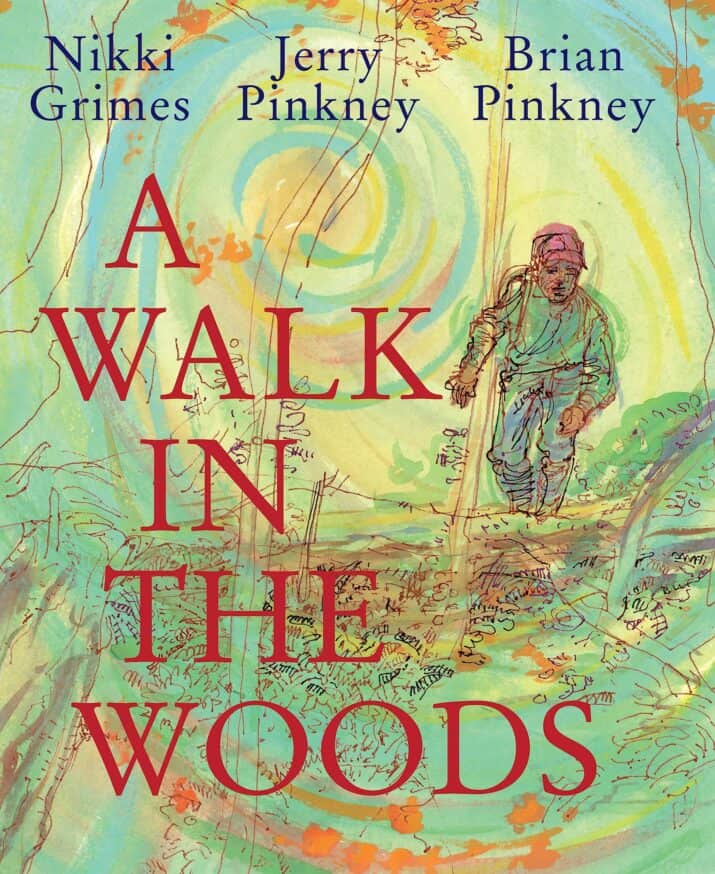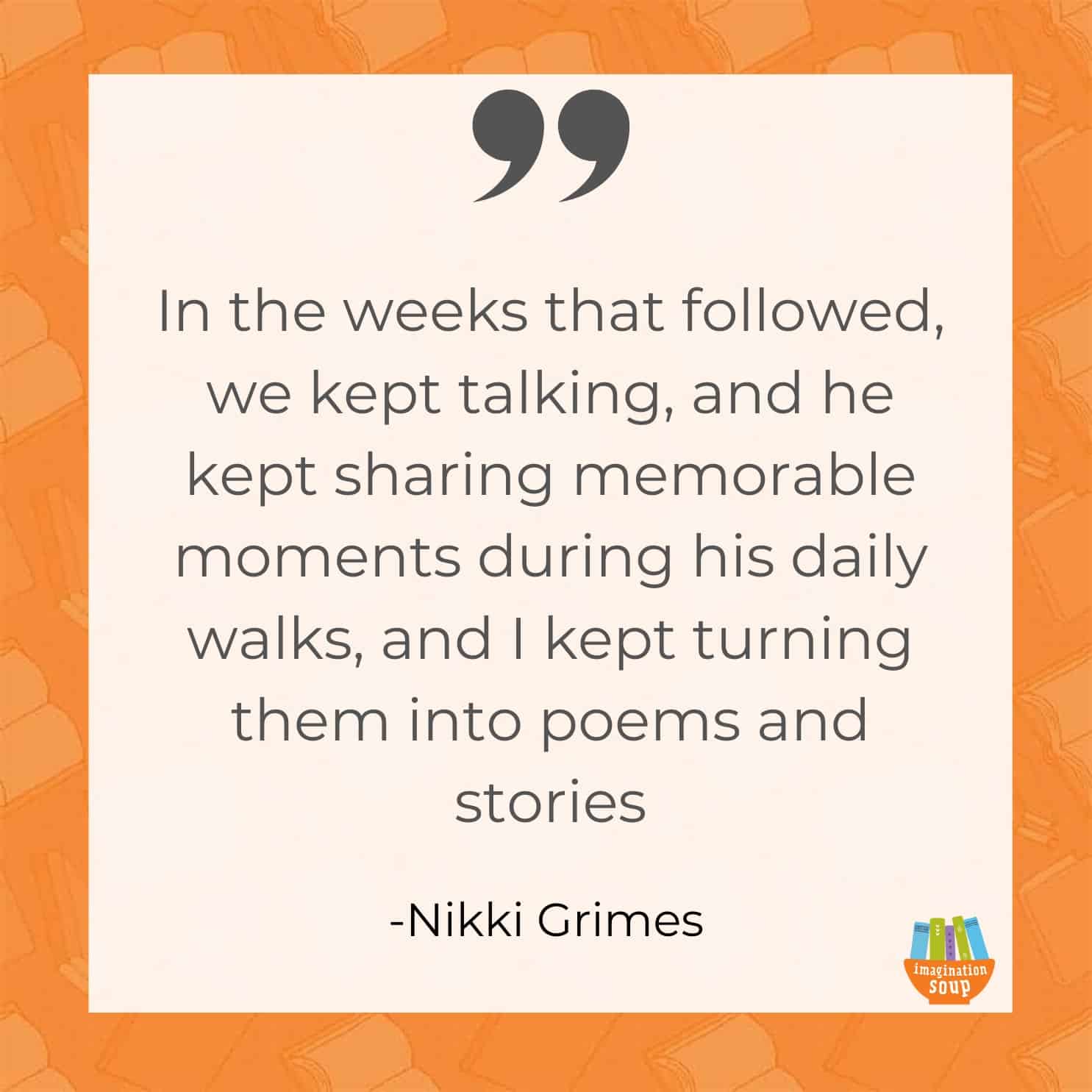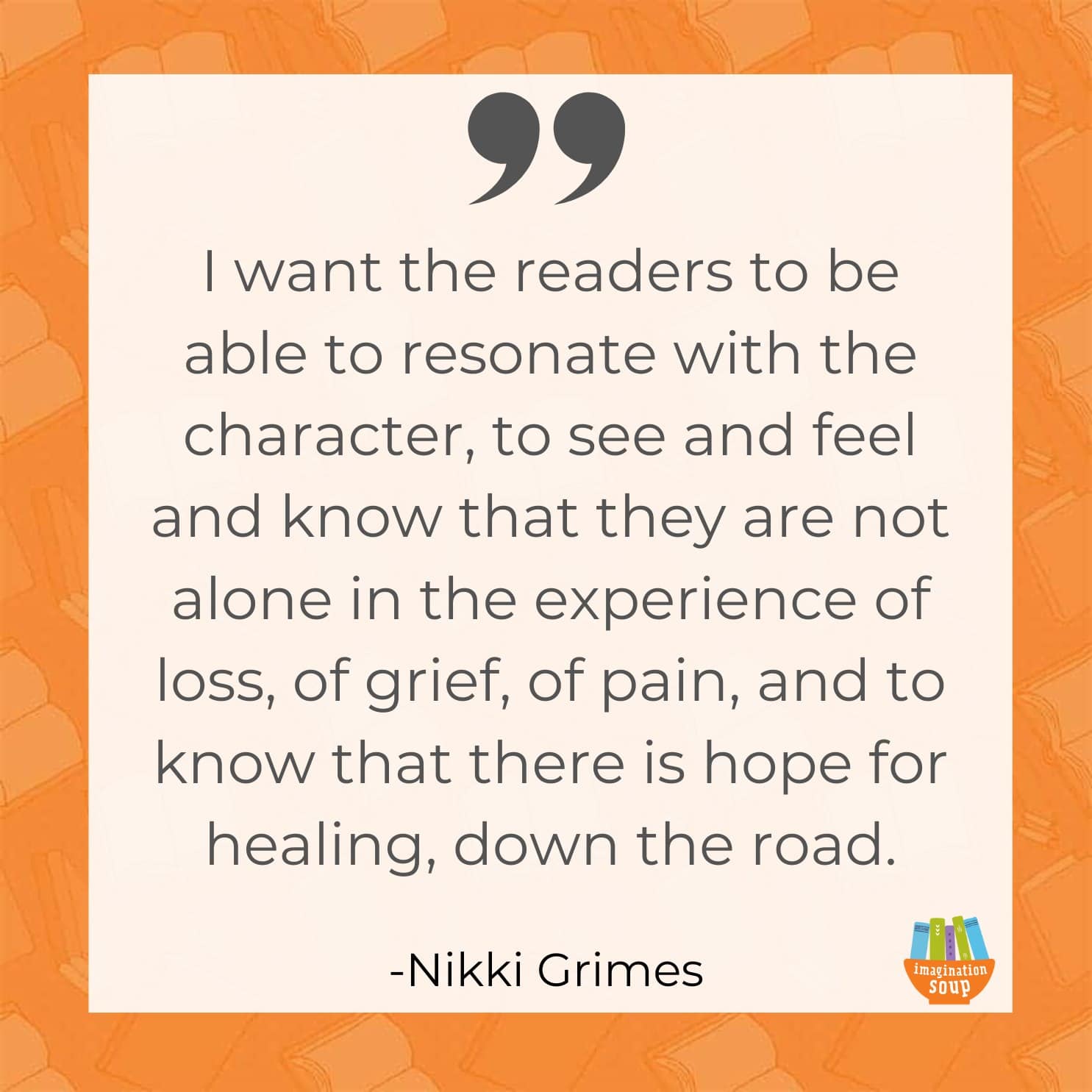Interview with Nikki Grimes about Friendship, Representation & Grief
This post may contain affiliate links.
Award-winning and NYT best-selling author, Nikki Grimes, was in the middle of collaborating on a picture book titled A Walk in the Woods with Jerry Pinkney when she received news, on her birthday, that he had died. After months of not being sure if their project would be completed, Jerry’s wife reached out to Nikki to share that Jerry had finished sketches for all of the art in the book. The book, which continues to garner starred reviews, will be released on September 12, 2023.

Melissa asked me to interview my mentor and dear friend, Nikki Grimes, about the creation journey of A Walk in the Woods. I’m thrilled to share our conversation with you.
A Walk in the Woods: An Interview with Nikki Grimes about Friendship, Representation, and Grief

AM: The idea of a collaboration on the Walk in the Woods project came about from Jerry’s wife, Gloria. How long did it take you to agree on what you wanted to tackle together?
NG: Less than five minutes! The drive to see more books featuring Black characters engaging in nature was something both Jerry and I were laser-focused on. We immediately jumped to that general theme. It was absolutely a no-brainer. Now, what shape that theme would take was another matter, altogether. The eventual storyline I came up with was an infuriatingly difficult one to get to.
AM: Have you ever worked on a picture book with an illustrator who was a friend? What was it like to collaborate on this with Jerry? Would you let us in on a glimpse of what your partnership looked like?
NG: Whoa! Slow down! That’s a lot. First, I’ve written any number of books that friends have illustrated, but that’s quite different from collaborating with an artist on a book from the very beginning of inception. This project with Jerry was unique in every way. It was truly birthed by us both, at the same time, working in tandem. Did Jerry know what the storyline would be? No, but then neither did I! But the disparate sketches and anecdotes he shared with me helped fuel the storyline that eventually emerged.
In the beginning, I tried coming up with storyline ideas that Jerry could illustrate, and he kept saying no to them, and not because they weren’t workable, or worthy, or interesting, but because he wanted this book to be a conversation between an author and an artist—between him and I. It took a while for me to figure out how to achieve that, or what that might look like. Until I did, we just kept talking.
I hit upon the idea of traveling to Croton-on-Hudson, where Jerry and Gloria lived, to visit for a week in the spring of 2020, and to join Jerry on his daily walks in the woods, taking my camera and notebook, and brainstorming—while actually in this environment—about the book we would create together. Great plan, right? Well, it was, right up until the pandemic shut down our world. I had to come up with Plan #2. I asked Jerry to start taking his camera on his walks, and to make videotapes for me. That was the closest I could come to seeing the woods that he walked everyday, which we’d agreed on as the setting of our book.
Good to his word, Jerry started sending me videos, every few days or so, allowing me to see some of what he saw on his walks, and we continued our regular conversations by phone and email.
One day, during a conversation, he shared some anecdotes about a recent walk in the woods, what he saw and experienced encountering a particular creature and, in the midst of the telling, I stopped him. “Jerry,” I said excitedly, “That story that you just told me? Write it down and send it to me.” I didn’t know exactly what I was going to do with it, but I felt it might be a key for me. He agreed, mentioning he’d done a few sketches while on his walk, and I asked him to send those, too.
I sat with that first story, and those first sketches, and translated them into a poem. In the weeks that followed, we kept talking, and he kept sharing memorable moments during his daily walks, and I kept turning them into poems and stories. Mind you, I had no idea where I was going with this, but I believed I would figure it out.

I had all these disparate images and poems, and the question was still how to bring them all together, how to shape them into a cohesive narrative. I needed a skeletal storyline, a solid frame onto which to hang these unconnected poems/sketches/bits of story. Another artist friend suggested I might find inspiration in The Mysteries of Harris Burdick by Chris Van Allsburg, and she was right. After revisiting that book, I came away with the idea of creating a mystery. Mind you, I’ve never written a mystery in my life, but I thought I could come up with something simple, like a treasure hunt, using the sketches and bits of story as the treasure! After that, I was off and running.
AM: Both you and Jerry work/worked intentionally to dignify the African-American experience in children’s literature. Would you talk about the passion you shared for representation and how it is reflected in this book?
NG: Well, both Jerry and I were born artists, and I can’t imagine either of us landing somewhere other than the arts, at this point. That said, the drive behind both his work and mine, whether in or outside of children’s literature, was representation. For myself, growing up as an avid reader, it bothered me that I encountered so few people in books who looked like me, or had the kind of life that I had, and I determined to address that dearth in literature when I entered the field. Initially, my trajectory was towards adult literature, but God clearly had other plans! Children’s literature turned out to be a place where my voice was needed. As for A Walk in the Woods, in particular, the passion behind it was, again, my and Jerry’s shared desire to contribute to the too-small list of children’s books featuring Black characters engaging in nature.

AM: This is not the first time you have written pointedly about grief. What do you take into consideration as you explore such a difficult topic for children?
NG: Of course, I’m always looking to be delicate in handling such a topic for young readers, but I’m also intent on being honest with them. I choose to honor their intelligence, as well as the truth of their emotions—difficult though they may be. Otherwise, what’s the point? I want the readers to be able to resonate with the character, to see and feel and know that they are not alone in the experience of loss, of grief, of pain, and to know that there is hope for healing, down the road. If readers don’t believe in the authenticity of the character’s grief/sorrow/pain, then they won’t believe in the hope for healing represented either. So, my job is to weave both into the story.

AM: What was it like for you to lose your friend Jerry in the middle of your collaboration? How did the book get finished? How is it significant that this was Jerry’s last book?
NG: I cannot swear that this was Jerry’s last book, though I know it was at least one of them.
Losing Jerry at any time would have been heartbreaking, but losing him before the book could go out in the world was excruciating. The floor fell out from underneath me. I’d completed the manuscript, knew Jerry had started work on the art, but had no idea if he’d completed the work, or how far along he’d actually gotten. The question, then, was whether or not this unique collaboration would ever see the light of day! I’m grateful that it has—and in such an unimaginably perfect manner. Of course, I’m referring to Jerry’s son, Brian Pinkney, coming on board to complete the book by adding painting to the technical drawings his father managed to complete before he died.
AM: What was it like for you to watch award-winning illustrator Brian Pinkney step in and finish the collaboration you had begun with his father?
NG: I had my heart in my mouth, and so did Brian. I was, first and foremost, grateful that he agreed to take this on—it was no small decision for him. He was still very much carrying the grief of his monumental loss when he was asked to do this. Then, from my end, I didn’t know exactly what to expect as far as what the finished product would look like. I was quite familiar with—and admiring of—Brian’s work, but his father’s work was quite specific, and that’s the work I had in mind when I wrote the book. So, there was that. Of course, looking at the work now, and hearing Brian talk about the emotional watershed moments the work provided, and the healing it offered him in the process, I can’t imagine any more perfect way for this work to be ushered into the world. I see God’s handprint everywhere in this work, and I feel Jerry smiling down—on Brian, and on me.

About Nikki Grimes

New York Times bestselling author Nikki Grimes is the recipient of the 2022 Virginia Hamilton Lifetime Achievement Award, the 2020 ALAN Award for outstanding contributions to young adult literature, the 2017 Children’s Literature Legacy Award, the 2016 Virginia Hamilton Literary Award, and the 2006 NCTE Award for Excellence in Poetry for Children. Her distinguished works include the much-honored books Garvey’s Choice, ALA Notable book Southwest Sunrise, Coretta Scott King Award winner Bronx Masquerade, and five Coretta Scott King Author Honor books, Printz and Siebert Honor winner Ordinary Hazards, Boston Globe-Horn Book Honor One Last Word, its companion Legacy: Women Poets of the Harlem Renaissance, and NYT Bestseller Kamala Harris: Rooted in Justice. Creator of the popular Meet Danitra Brown, Make Way for Dyamonde Daniel, Bedtime for Sweet Creatures, and Off to See the Sea, Ms. Grimes lives in Corona, California.

KEEP READING











What a wonderful, moving interview. I’m glad A WALK IN THE WOODS made it through and was able to be published and that Jerry had the chance to illustrate the ‘bones’ of it. Congratulations, Nikki!